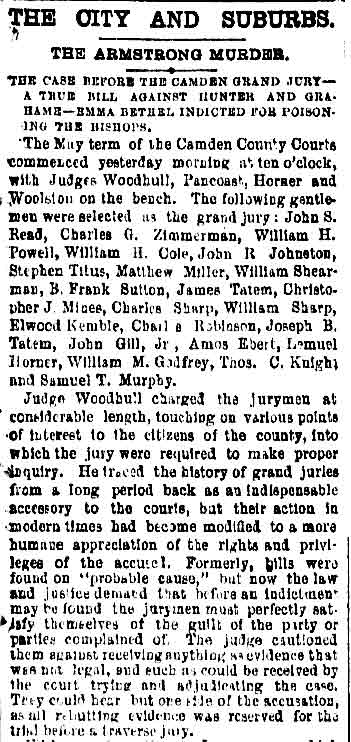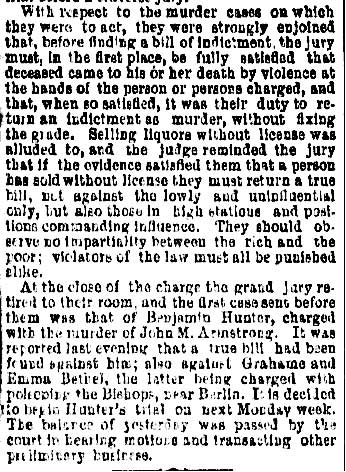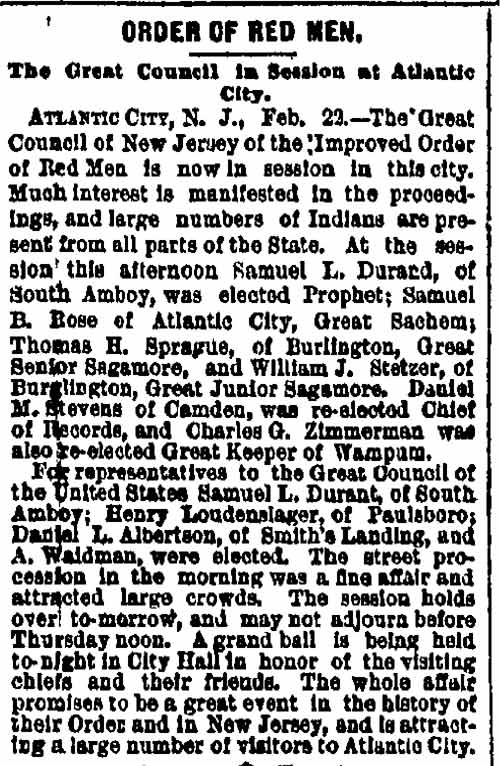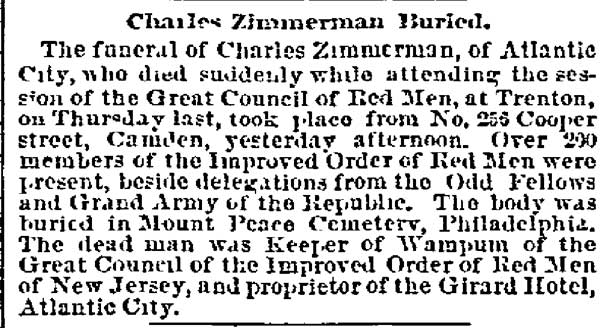|
Charles |
|
CHARLES GOTTLIEB ZIMMERMAN was one of the original members of the Camden Fire Department, entering service on September 2, 1869 as as extra man of the Hook and Ladder Company, the original designation of what is now Ladder Company 1. His brother Theodore A. Zimmerman was also an original member of the department, serving with Engine Company 2. Charles G. Zimmerman was the son of Gottlieb and Mary Zimmerman. He was born in Philadelphia on January 6, 1841. The family lived in Philadelphia through at least 1845 before moving to New Jersey. The Census of 1850 shows the family living in Camden's North Ward. Besides Charles and his parents the family included older siblings Andrew, Rose, Caroline, Theodore and Hannah, and a younger children Louisa and Henry. Gottlieb Zimmerman's occupation was given as landlord, in 1860 his occupation was "gentleman". He was well known in Camden, operating a resort known as The Tub on the site of the old Columbia Gardens where Market Street met Arch Street, east of North 5th Street. He later owned and occupied Diamond Cottage, on the present-day site of the Ben Franklin Bridge toll plaza. The 1860 Census shows Charles, his parents and younger siblings living in Camden's North Ward. |
|||||||||||||||||||||||||||||||||||||
|
On the 16th of April, 1861, three days after the Confederates fired upon Fort Sumter, at the entrance of Charleston Harbor, a large number of loyal and patriotic citizens of Camden City and County, including Charles G. Zimmerman, signed the following vigorous and spirited response to the President's proclamation :
“ To the President of the United States :
Charles G. Zimmerman served in Civil
War as a Sergeant with the Company F, 4th Regiment, New Jersey Infantry,
from April 27 to July 31, 1861. His older brother Theodore also served,
as did others who would play a role in Camden in future years.
This regiment was mustered into the U. S. service at Trenton, April 27,
1861, to serve for three months, and left the state for Washington,
Charles
G. Zimmerman subsequently re-enlisted. He served as First Lieutenant and
Adjutant, Company F, 2nd Regiment, Pennsylvania, Heavy Artillery (112th
Volunteers),
from November 22, 1861 to December 27, 1862. This unit undertook
garrison duty in and around Washington during Zimmerman's time in
service. In addition to his service with the fire department Charles G. Zimmerman ran a hotel on the northwest corner of South 2nd Street and Bridge Avenue. Fellow Camden firefighter Richard Houghtaling had worked for him there as a bartender. Charles G. Zimmerman was living at South 2nd Street and Bridge Avenue when he joined the department in the fall of 1869. On September 2, 1869 City Council enacted a municipal ordinance creating a paid fire department. It provided for the annual appointment of five Fire Commissioners, one Chief Marshal (Chief of Department) and two Assistant Marshals. The City was also divided into two fire districts. The boundary line ran east and west, starting at Bridge Avenue and following the tracks of the Camden and Amboy Railroad to the city limits. District 1 was south of this line and District 2 was north. The commissioners also appointed the firemen who were scheduled to work six 24 hour tours per week. William Abels, from the Weccacoe Hose Company No. 2 was appointed Chief Marshal with William J. Mines, from the Independence Fire Company No. 3 as Assistant Marshal for the 1st District, and William H. Shearman as the Assistant Marshal for the 2nd District. Abels had served with the volunteer fire departments of Philadelphia, Mobile, Alabama and Camden for sixteen years prior to his appointment as Chief of the paid force. On November 10, 1869 City Council purchased the Independence Firehouse, the three-story brick building at 409 Pine Street, for $4500. The building was designated to serve as quarters for Engine Company 1 and the 1st District. On October 29, 1869 City Council authorized construction of a two-story brick building on the northwest corner of Fifth and Arch Streets as quarters for the 2nd District. On November 25th the Fire Commissioners signed a contract with M.N. Dubois in the amount of $3100 to erect this structure. The 2nd District would share these quarters with Engine Company 2 and the Hook & Ladder Company and the facility would also serve as department headquarters for the new paid force. The original contract remains part of the Camden County Historical Society collection.
Two Amoskeag second class, double pump, straight frame steam engines were purchased at a cost of $4250 each. Two Silsby two wheel hose carts, each of which carried 1000 feet of hose, were another $550 each and the hook & ladder, built by Schanz and Brother of Philadelphia was $900. Each engine company received a steam engine and hose cart. Amoskeag serial #318 went to Engine Company 1, and serial #319 to Engine Company 2. The Fire Commission also secured the services of the Weccacoe and Independence steamers in case of fire prior to delivery of the new apparatus. Alfred McCully of Camden made the harnesses for the horses. Camden's Twoes & Jones made the overcoats for the new firemen and a Mr. Morley, also of Camden, supplied the caps and belts which were manufactured by the Migeod Company of Philadelphia. The new members were also issued badges.
Badges worn by the marshals, engineers, stokers and engine drivers bore the initial letter of their respective positions and their district number. The tillerman and his driver used the number "3" to accompany their initial letter. The extra men of the 1st District were assigned badges 1-10; 2nd District badges were numbered 11-20 and the extra men of the hook & ladder wore numbers 21-30. Although the Fire Commission intended to begin operation of the paid department on November 20, 1869, the companies did not actually enter service until December 7th at 6 P.M. because the new apparatus and buildings were not ready. The new apparatus was not tried (tested) until December 9th. The new members of the paid force were:
The Board of Fire Commissioners consisted of Rudolphus Bingham, Chairman and Samuel C. Harbert, Richard Perks, Jonathon Kirkbride and Jacob Daubman.
Annual salaries for the members of the paid force were: Chief Marshal, $800; Assistant Marshal, $200; Engineer, $600; Driver, $450; Stoker, $450; Tillerman, $450; Extra Men, $50. All but Extra Men were paid monthly. Charles G. Zimmerman was a member of the Thomas M.K. Lee Post No. 5, Grand Army of the Republic (G.A.R.). Charles G. Zimmerman was also a member of the Wyoming Tribe No. 55 of the Improved Order of Red Men, as were fellow Camden Fire Department members James M. Lane and Joseph H. Minnett. George Reeser Prowell, in his History of Camden County, New Jersey, published in 1886, wrote the following about this organization: WYOMING TRIBE, No. 55, was instituted July 8, 1880. The Great Chiefs present were Great Prophet, Wm. P. Hall; Great Sachem, James M. Smith; G.C. of R., John T. Davis. The first Chiefs of the tribe were Prophet, Joseph H. Minnett; Sachem, Alonzo Bicking; Senior Sagamore, Chas. G. Zimmerman; Junior Sagamore, Wm. F. Propert; C. of R., D.C. Vannote; K. of W., Jos. B. Fox. The present Chiefs - P., J.A. Dold; S., Henry C. Boddy; S.S., Wm. B. Bignell; J.S., Wm. J. Boddy; C. of R., D.C. Vannote; K. of W., J.B. Fox. The number of members is one hundred and fifty-eight. The lodge meets Wednesday evenings at Third and Market Streets. Charles G. Zimmerman left the Fire Department on January 8, 1872. He stopped appearing in Camden's City Directories in 1885. He moved to Atlantic City and opened a hotel known as the Girard House at 2001 Atlantic Avenue. He passed away in Trenton, New Jersey while attending the state convention of the Improved order of Red Men on February 28, 1889. His widow, Mrs. Keturah Zimmerman, stayed in Atlantic City and ran the hotel for a short time. She was still living in Atlantic City as late as 1901. Mrs. Zimmerman passed away in 1917. Charles G. Zimmerman's nephew, Arthur A. Zimmerman, the son of his brother Theodore, was the premier bicycle racing champion of the 1890s and early 1900s. |
|||||||||||||||||||||||||||||||||||||
![]()
|
1861- THE FIRST WAR MEETING IN CAMDEN |
||||
|
On the 16th of April, 1861, three days after the Confederates fired upon Fort Sumter, at the entrance of Charleston Harbor, a large number of loyal and patriotic citizens of Camden City and County issued the following vigorous and spirited response to the President's proclamation: " To the President Of the United States: " The unparalleled events of the last week have revealed to the citizens of the United States, beyond question or the possibility of a doubt, that peaceful reconciliation upon the form of our Con-stitution is repelled and scorned, and secession means, in the hearts of its supporters, both Trea-son and war against our Country and Nation. " We, therefore, the undersigned Loyal Citizens of the United States, and inhabitants of the city of Camden, in the State of New Jersey, responding to the proclamation of the President of the United States, hereby declare our unalterable determination to sustain the government in its efforts to maintain the honor, the integrity and the existence of our National Union and the perpetuity of the popular Government, and to redress the wrongs already long enough endured; no differences of political opinion; no badge of diversity upon points of party distinction, shall restrain or withhold us in the devotion of all we have or can command to the vindication of the Constitution, the maintenance of the laws and the defense of the Flag Of our Country."
In
response to a call, on the 18th of April an enthusiastic meeting was
held in the county court-house, which was formed of a large collection
of prominent citizens. The court-room was decorated with flags and
mottoes. John W. Mickle was chosen president and Samuel C. Harbert and
Thomas G. Rowand secretaries. The president addressed the meeting first
and Rev. Mr. Monroe offered a prayer. Hon. Thomas P. Carpenter,
Thomas
B. Atkinson (mayor) and Joseph Painter were appointed a committee on
resolutions. Judge Philip J. Grey addressed the meeting, after which the
committee adopted a long series of patriotic resolutions. The Washington
Grays, Stockton Cadets and the Zouaves marched into the room and were
received with cheers, Samuel Hufty read a resolution which was signed by
many persons, who immediately formed the Home Brigade. David M.
Chambers, Captain Stafford,
Benjamin
M. Braker, John
H. Jones and E. A. Acton each addressed the meeting. James M. Scovel
was then called upon and responded in eloquent terms and with patriotic
energy. S. H. Grey offered a resolution, which was adopted, that the
City Council and the Freeholders of the county be requested to
appropriate money for the equipment of persons who may volunteer in
defense of the country, and S. H. Grey,
James
M. Cassady and Joseph Painter were appointed a committee to look
after the interests of the resolution. The meeting continued in session
until eleven p.m. |
![]()

|
Philadelphia
Inquirer William
H. Shearman -
John S. Read |

|
|
|
Judge John T.
Woodhull - Benjamin Hunter - John M. Armstrong - Emma Bethel |
|
|
Philadelphia Inquirer - February 23, 1884 |

|
| Daniel M. Stevens - Charles G. Zimmerman |
|
Philadelphia Inquirer - March 4, 1889 |

|
| Cooper Street |